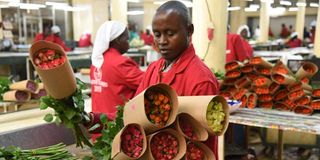Flower sector winning virus war

Employees at Equator Flowers Farm in Eldoret, Uasin Gishu County pack flowers for export on March 16, 2020.
What you need to know:
- The containment measures employed by various countries also reduced the high demand that our flowers usually enjoy.
- The country has, however, remained committed to bringing the sector back to its vibrant self.
Kenya prides itself of a blooming flower sector. According to the Kenya Flower Council, our flower exports grew from 10,946 tonnes in 1988 to 161,227 tonnes in 2018 — a growth rate of 10 per cent for more than three decades.
Both the volume and value of flower exports have grown over the past three decades, placing the country as Africa’s lead cut flower exporter.
Globally, Kenya ranks as the fourth-largest exporter of flowers, behind the Netherlands, Colombia and Ecuador.
Similarly, in terms of trade balance, it is the fourth-largest net exporter of cut flowers globally. Our cut flowers, especially roses, are among the those with the most demand worldwide.
Our primary export destination for cut flowers, especially roses, is the Netherlands. Other key markets for our cut flowers are the United Kingdom, Germany, Saudi Arabia and United Arab Emirates (UAE).
Over the past five years, demand for cut flowers has grown faster in China, Oman, Kuwait, Saudi Arabia and UAE than in other countries. These are markets for which Kenyan exporters may consider diversifying into or increasing engagement with for enhanced export trade relations.
The Horticultural Crops Directorate notes that about half of Kenya’s exports of cut flowers land in the Netherlands for the Dutch flower auction before being sold across Europe. Direct sales to the export markets occur at a lesser extent.
It is no secret that the Covid-9 pandemic occasioned a multitude of challenges to the sector. Demand for the commodity had declined significantly, dealing a massive blow to the local farmers and exporters.
The containment measures employed by various countries also reduced the high demand that our flowers usually enjoy.
Most European nations — our lead export destination for flowers — recorded rapidly growing numbers of Covid-19 cases, which prompted interventions aimed at curbing the spread of the coronavirus.
Most of the flowers exported in Europe in the early days of the pandemic were destroyed as the markets and borders were closed and logistics priority given to food and other essential items.
Travel bans to Europe adversely affected the supply chains and demand side, especially where direct marketing was involved.
Airfreight cancellations owing to increased incidence of the disease also hurt the industry as flowers remained unsold.
As a result, the value of Kenya’s exports to its lead flower export destination, the Netherlands, declined to Sh8.8 billion between April and June 2020 from Sh11.4 billion in the same period last year.
Started picking up
The country has, however, remained committed to bringing the sector back to its vibrant self. Supply side interventions such as allowing airfreight and tax restructuring were successfully taken up to cushion the sector players from the impact of the pandemic.
Besides, the recent easing of lockdown by European countries has rejuvenated the demand for flowers and gave hope for full recovery of the industry.
According to the Kenya Flower Council, the demand for flowers has started picking up and is expected to be at near-normal levels in a short time. Holding other factors constant, the industry is expected to fully bounce back by early next year.
In addition, the expected stimulus package to the horticultural sector should improve on the competitiveness of the sector by stabilising national production.
If anything, the pandemic has taught us how resilient our flower sector is. By July, cut flower exports had picked up from the devastation wrought by the pandemic, which broke out last year. Exports of cut flowers were estimated at Sh15.5 billion between July and September — Sh2.8 billion higher than the same period last year.
Evidently, Kenya’s commitment to facilitate trade remains steadfast. As witnessed, investment into logistic support has been prioritised.
The Kenya Export Promotion and Branding Agency assists producers and exporters to navigate the export sector and to position ready export products in 22 key markets with the aim of achieving increased export growth.
The support includes capacity building training for exporters; product development through instructive programmes; test marketing of export-ready products; and the export development programme, which identifies events, expos, trade missions and so on to provide visibility for our export products.
The agency has partnered with stakeholders in the horticulture sector, where flowers play a critical role, to develop an integrated marketing communication strategy to achieve a coordinated communication programme that is customer-focused and consistent towards a competitive advantage for the horticultural produce.
But this is threatened by a second wave of the pandemic that continues to threaten our traditional markets in the UK and EU. That accelerates the need for the horticulture sector to diversify into new markets, including Africa, and work towards a more competitive logistical infrastructure.
Dr Marube is CEO, Kenya Export Promotion and Branding Agency. @wmarube





